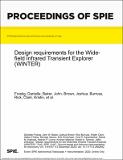| dc.contributor.author | Frostig, Danielle | |
| dc.contributor.author | Baker, John W | |
| dc.contributor.author | Brown, Joshua | |
| dc.contributor.author | Burruss, Rick | |
| dc.contributor.author | Clark, Kristin | |
| dc.contributor.author | Furész, Gábor | |
| dc.contributor.author | Ganciu, Nicolae | |
| dc.contributor.author | Hinrichsen, Erik | |
| dc.contributor.author | Karambelkar, Viraj R | |
| dc.contributor.author | Kasliwal, Mansi M | |
| dc.contributor.author | Lourie, Nathan P | |
| dc.contributor.author | Malonis, Andrew | |
| dc.contributor.author | Simcoe, Robert A | |
| dc.contributor.author | Zolkower, Jeffry N | |
| dc.date.accessioned | 2022-04-29T17:02:33Z | |
| dc.date.available | 2022-04-29T17:02:33Z | |
| dc.date.issued | 2020 | |
| dc.identifier.uri | https://hdl.handle.net/1721.1/142211 | |
| dc.description.abstract | The Wide-field Infrared Transient Explorer (WINTER) is a 1x1 degree infrared
survey telescope under development at MIT and Caltech, and slated for
commissioning at Palomar Observatory in 2021. WINTER is a seeing-limited
infrared time-domain survey and has two main science goals: (1) the discovery
of IR kilonovae and r-process materials from binary neutron star mergers and
(2) the study of general IR transients, including supernovae, tidal disruption
events, and transiting exoplanets around low mass stars.
We plan to meet these science goals with technologies that are relatively new
to astrophysical research: hybridized InGaAs sensors as an alternative to
traditional, but expensive, HgCdTe arrays and an IR-optimized 1-meter COTS
telescope. To mitigate risk, optimize development efforts, and ensure that
WINTER meets its science objectives, we use model-based systems engineering
(MBSE) techniques commonly featured in aerospace engineering projects. Even as
ground-based instrumentation projects grow in complexity, they do not often
have the budget for a full-time systems engineer. We present one example of
systems engineering for the ground-based WINTER project, featuring software
tools that allow students or staff to learn the fundamentals of MBSE and
capture the results in a formalized software interface. We focus on the
top-level science requirements with a detailed example of how the goal of
detecting kilonovae flows down to WINTER's optical design. In particular, we
discuss new methods for tolerance simulations, eliminating stray light, and
maximizing image quality of a fly's-eye design that slices the telescope's
focus onto 6 non-buttable, IR detectors. We also include a discussion of safety
constraints for a robotic telescope. | en_US |
| dc.language.iso | en | |
| dc.publisher | SPIE-Intl Soc Optical Eng | en_US |
| dc.relation.isversionof | 10.1117/12.2562842 | en_US |
| dc.rights | Article is made available in accordance with the publisher's policy and may be subject to US copyright law. Please refer to the publisher's site for terms of use. | en_US |
| dc.source | SPIE | en_US |
| dc.title | Design requirements for the Wide-field Infrared Transient Explorer (WINTER) | en_US |
| dc.type | Article | en_US |
| dc.identifier.citation | Frostig, Danielle, Baker, John W, Brown, Joshua, Burruss, Rick, Clark, Kristin et al. 2020. "Design requirements for the Wide-field Infrared Transient Explorer (WINTER)." Ground-based and Airborne Instrumentation for Astronomy VIII. | |
| dc.contributor.department | Massachusetts Institute of Technology. Department of Physics | |
| dc.contributor.department | MIT Kavli Institute for Astrophysics and Space Research | |
| dc.contributor.department | Lincoln Laboratory | |
| dc.relation.journal | Ground-based and Airborne Instrumentation for Astronomy VIII | en_US |
| dc.eprint.version | Final published version | en_US |
| dc.type.uri | http://purl.org/eprint/type/ConferencePaper | en_US |
| eprint.status | http://purl.org/eprint/status/NonPeerReviewed | en_US |
| dc.date.updated | 2022-04-29T16:57:35Z | |
| dspace.orderedauthors | Frostig, D; Baker, JW; Brown, J; Burruss, R; Clark, K; Furész, G; Ganciu, N; Hinrichsen, E; Karambelkar, VR; Kasliwal, MM; Lourie, NP; Malonis, A; Simcoe, RA; Zolkower, JN | en_US |
| dspace.date.submission | 2022-04-29T16:57:41Z | |
| mit.license | PUBLISHER_POLICY | |
| mit.metadata.status | Authority Work and Publication Information Needed | en_US |
